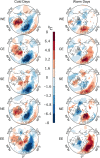Effects of the tropospheric large-scale circulation on European winter temperatures during the period of amplified Arctic warming
- PMID: 32025090
- PMCID: PMC6988488
- DOI: 10.1002/joc.6225
Effects of the tropospheric large-scale circulation on European winter temperatures during the period of amplified Arctic warming
Abstract
We investigate factors influencing European winter (DJFM) air temperatures for the period 1979-2015 with the focus on changes during the recent period of rapid Arctic warming (1998-2015). We employ meteorological reanalyses analysed with a combination of correlation analysis, two pattern clustering techniques, and back-trajectory airmass identification. In all five selected European regions, severe cold winter events lasting at least 4 days are significantly correlated with warm Arctic episodes. Relationships during opposite conditions of warm Europe/cold Arctic are also significant. Correlations have become consistently stronger since 1998. Large-scale pattern analysis reveals that cold spells are associated with the negative phase of the North Atlantic Oscillation (NAO-) and the positive phase of the Scandinavian (SCA+) pattern, which in turn are correlated with the divergence of dry-static energy transport. Warm European extremes are associated with opposite phases of these patterns and the convergence of latent heat transport. Airmass trajectory analysis is consistent with these findings, as airmasses associated with extreme cold events typically originate over continents, while warm events tend to occur with prevailing maritime airmasses. Despite Arctic-wide warming, significant cooling has occurred in northeastern Europe owing to a decrease in adiabatic subsidence heating in airmasses arriving from the southeast, along with increased occurrence of circulation patterns favouring low temperature advection. These dynamic effects dominated over the increased mean temperature of most circulation patterns. Lagged correlation analysis reveals that SCA- and NAO+ are typically preceded by cold Arctic anomalies during the previous 2-3 months, which may aid seasonal forecasting.
Keywords: Arctic; European weather; North Atlantic oscillation; Scandinavian pattern; subsidence heating; teleconnections.
© 2019 The Authors. International Journal of Climatology published by John Wiley & Sons Ltd on behalf of the Royal Meteorological Society.
Figures












References
-
- Barnston, A.G. and Livezey, R.E. (1987) Classification, seasonality and persistence of low frequency atmospheric circulation patterns. Monthly Weather Review, 115, 1083–1126.
-
- Bojariu, R. and Reverdin, G. (2002) Large‐scale variability modes of freshwater flux and precipitation over the Atlantic. Climate Dynamics, 18, 369–381.
-
- Buckley, M.W. and Marshall, J. (2016) Observations, inferences, and mechanisms of Atlantic meridional overturning circulation variability: a review. Reviews of Geophysics, 54, 5–63. 10.1002/2015RG000493. - DOI
-
- Bueh, C. and Nakamura, H. (2007) Scandinavian pattern and its climate impact. Quarterly Journal of the Royal Meteorological Society, 133, 2117–2131.
-
- Cassou, C. , Terray, L. , Hurrell, J.W. and Deser, C. (2004) North Atlantic winter climate regimes: spatial asymmetry, stationarity with time, and oceanic forcing. Journal of Climate, 17, 1055–1068.
LinkOut - more resources
Full Text Sources
